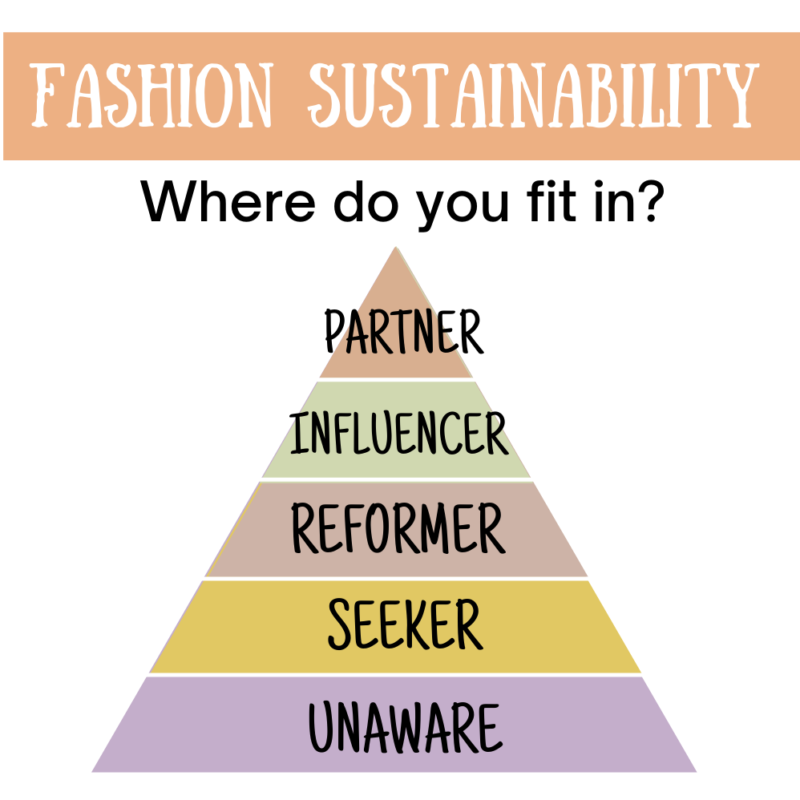Most of us want to move towards fashion sustainability. We want to help the planet and human kind. I believe everyone has a place in the movement towards sustainability and hopefully this info will help you find your place.
I have five fashion sustainability categories with examples in each category. But these lists are by no means complete. With some questioning and research you will hopefully find a way to make a difference, starting with your own closet, then your community.
“You cannot get through a single day without having an impact on the world around you. What you do makes a difference, and you have to decide what kind of difference you want to make.”
Jane Goodall

1. Unaware
The majority of the population is unaware of the high cost of fashion to our environment and human kind. They are not aware that garment workers are toiling away to make clothing that is worn only a few times, or worse, destroyed before it’s even sold. Producing the fabric for garments uses our natural resources, pollutes our water and harms our planet. Understanding that there is a problem is the first step which takes a person out of this category and into the next. Thankfully every day more people become aware that there is a problem and want to learn more about fashion sustainability.
2. Seeker
The first step is gathering information
As word spreads about the negative impact our clothing habits have on the earth and fellow humans, many of us want to know more. We want to help. This is the stage where you are gathering information about fashion sustainability.
You’ve heard the term “fast fashion” and realize there is overconsumption and overproduction in the world when it comes to fashion. This is harmful to our planet and to humankind. You are curious about clothing alternatives to fast fashion. You begin to understand when a consumer buys a shirt for $3, there is a high cost to someone else, usually marginalized garment workers in third world countries.
“Seekers are saying enough is enough.”
Seekers are saying enough is enough; we need to stop the endless consumerism and lead more considered and intentional lives. We need to ditch fast and adopt a slower pace. And they want to know how.

3. reformed
You take action to reduce your consumption
It’s choosing to dress in a way that honors people, the planet, and animals. And slow fashion is about buying less and investing in better quality clothes. In essence, it is a conscious lifestyle that considers the true cost of fashion
This is where it all begins. You have changed your mindset and decided to dress in a way that honors people and the planet. You’ve decided that what you wear is not worth the cost. Having less looks good to you now.
“Every time you spend money, you’re casting a vote for the kind of world you want.”
Anne Lappe
- stop buying fast fashion
- reduce the number of clothing items you buy each year
- understand how to recycle, donate and reuse your clothes
- buy second hand and vintage clothing
- sew your own clothes
- try renting clothes for special occasions
It’s time to take steps to help reduce the overconsumption of garments. This is slow fashion. Slow fashion is a conscious approach to fashion. It’s an awareness and appreciation of the resources and processes which go into making our clothes. Sustainability and the best ethical practices are prioritized.
4. influencer
You not only reduce your own consumption but you encourage others to do the same.
Influencers believe they can make a difference if only enough people understood the problem. You spread the word, starting with your friends and family. You sign petitions for the cause, you write the people who are marginalizing the garment workers. Influencers get behind #payup and many other online platforms and demand action.
As an influencer spreading the word, you are helping the environment and your fellow humans tremendously. The goal is for less clothes to be produced and consumed, therefore reducing the waste that ends up in landfills, the toxic chemicals in our water, the non-renewable resources burned, the garment workers overworked and underpaid because no on is standing up for their rights.
An influencer can:
- talk to your friends and family and let them know the facts
- let brands know how you feel
- sign petitions for garment workers rights
- be aware and participate in sustainable movements, for example #payup
- volunteer at your local resale or thrift store to help further recycling
This is what fashion sustainability is all about.
5. partner
It’s not just you anymore, you have reached out and joined forces
This is where you have face to face contact with people you are trying to help and support. You are partnering with others to work towards a more sustainable world.
Basically, in all but extreme circumstances, you have to leave your house, get out in the world and lend a hand. This step has probably the broadest definition, from the small shop making sustainable clothing to an activist. There are many ways to be a partner in fashion sustainability and thankfully new ones are emerging all the time by innovative individuals and companies.
- helping to produce sustainable clothes either by sourcing and making clothes, or partnering with a business that does so
- supporting small weavers and dressmakers who are using sustainable materials to produce limited garments
- working with a group or belonging to an organization that is actively working towards a sustainable future in the garment industry

An activist is a leader with a voice
Activists are on the forefront of the fashion revolution movement to change the way the world sees and uses clothing. Activists have new ideas and are working to implement them. They are a force and will make a big difference to our environment and the marginalized garment workers in the world. An activist is not afraid to speak out against fast fashion. And they have the means, the support, passion and funding, to be heard.
Summary
There is a place for everyone in the movement towards fashion sustainability and every single person can make a difference. Every garment you reuse and every fast fashion garment you don’t buy make a difference. Thank you for reading!

